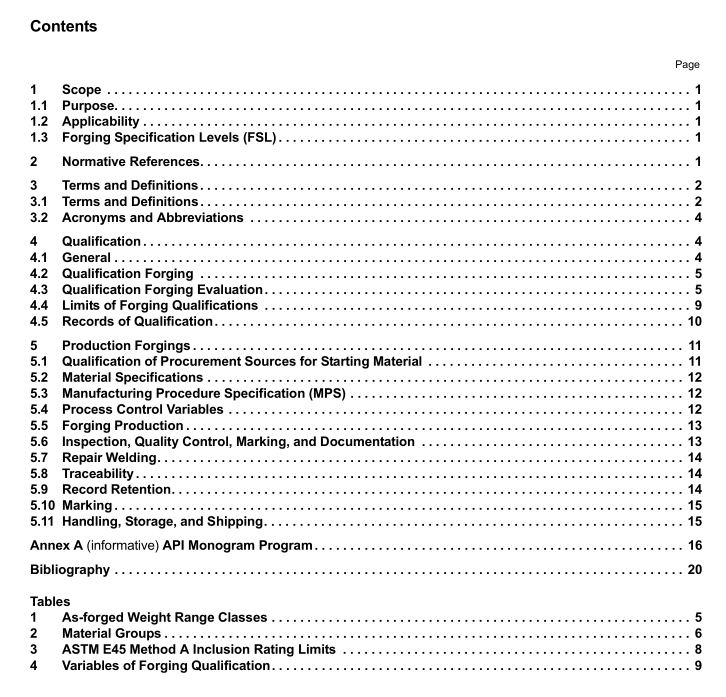API Spec 20B pdf download

API Spec 20B pdf download Open Die Shaped Forgings for Use in the Petroleum and Natural Gas Industry
4.3.3.2.1Sampling
As far as practical, the entire volume of each qualification forging shall be ultrasonically examined after heat treatmentfor mechanical properties and prior to machining operations that limit effective interpretation of the results of theexamination.For quench-and-tempered products, the volumetric inspection shall be performed after heat treatmentfor mechanical properties exclusive of stress-relief treatments or re-tempering to reduce hardness.
4.3.3.2.2Test Method
All forgings shall be examined by the ultrasonic method in accordance with the flat-bottom-hole procedures specifiedin AsTM A388/388M, except that the immersion method may be used, and ASTM E428.Hollow forgings shall beexamined using the angle beam method and acceptance criteria specified in ASTMA388/A388M.
The distance amplitude curve (DAC) shall be based on a 1/1e in.(1.6 mm) flat-bottom hole for metal thicknessesthrough 1/2 in. (38 mm), on a 1/8 in. (3.2 mm) flat-bottom hole for metal thicknesses from 1/2 in.(38 mm) through6 in.(150 mm), and on a 1/4 in.(6.4 mm) flat-bottom hole for metal thicknesses exceeding 6 in.(150 mm).
4.3.3.2.3 Acceptance Criteria
The following acceptance criteria apply:
a) no single indication exceeding reference distance amplitude curve;
b) no multiple indications exceeding 50 % of reference distance amplitude curve. Multiple indications are defined astwo or more indications (each exceeding 50 % of the reference distance amplitude curve) within 1/2 in.(13 mm) ofeach other in any direction.
4.3.4Test Piece
4.3.4.1Based on the size and complexity of the forging, the qualification forging shall be evaluated using at leastone of the following test pieces:
a) an integral prolongation, at a specified location;b) a sacrificial forging;
c) a separately forged QTC representing the largest cross section is permitted for FSL 1 only.
4.3.4.2When a prolongation is used,it shall remain integrally attached during all heat treatment operations exceptstress relief and any re-tempering or re-aging that may be required.
4.3.5 Mechanical Testing
4.3.5.1 Hardness testing shall be performed in accordance with ASTM E10,E110, or E18 on the cross section ofthe test piece, traversing the entire cross section in two perpendicular directions, with each traverse consisting of aminimum 5 points equally spaced across the cross section.Results shall be documented.
4.3.5.2Tensile test specimens shall be removed from the test piece and tested in accordance with ASTM A370 atthe following locations:
a) at or near the surface of the forging but not deeper than 11/4 in.(31.75 mm);
b) at 1/4T of the thickest cross section (T is defined as the thickest cross section of the forging in the as heat treated
condition);
c) at the location closest to 1/2T of the heaviest cross section of the forging in the final heat treated condition.
In all locations, as geometry permits, specimens shall be removed in the longitudinal and transverse direction to thegrain flow.
4.3.5.3 Charpy (CVN) impact specimens shall be removed from the 1/4T and 1/2T areas and tested in accordancewith ASTM A370 at a temperature specified by the material specification. in all locations, as long as the geometrypermits, specimens shall be removed in the longitudinal and transverse direction to the grain flow.Results shall bedocumented.
4.3.6Chemical Analysis
4.3.6.1 The forging supplier shall specify the nominal chemical composition, including composition tolerances, ofthe material used for the qualification forging.
4.3.6.2 Material composition shall be determined on a heat basis (or on a remelt-ingot basis for remelt-gradematerials) in accordance with a nationally or internationally recognized standard.
4.3.7Metallographic Examination—Applicable to FSL-3 and FSL-4 only4.3.7.1 General
4.3.7.1.1 A metallographic sample shall be removed from 2 locations, surface and 1/4T of the heaviest cross sectionof the prolongation or sacrificial forging.
4.3.7.1.2 For Group 1 and Group 2 materials, steel cleanliness shall be determined in accordance with ASTME45,Method A, and shall be within the limits shown in Table 3.The results shall be documented.









